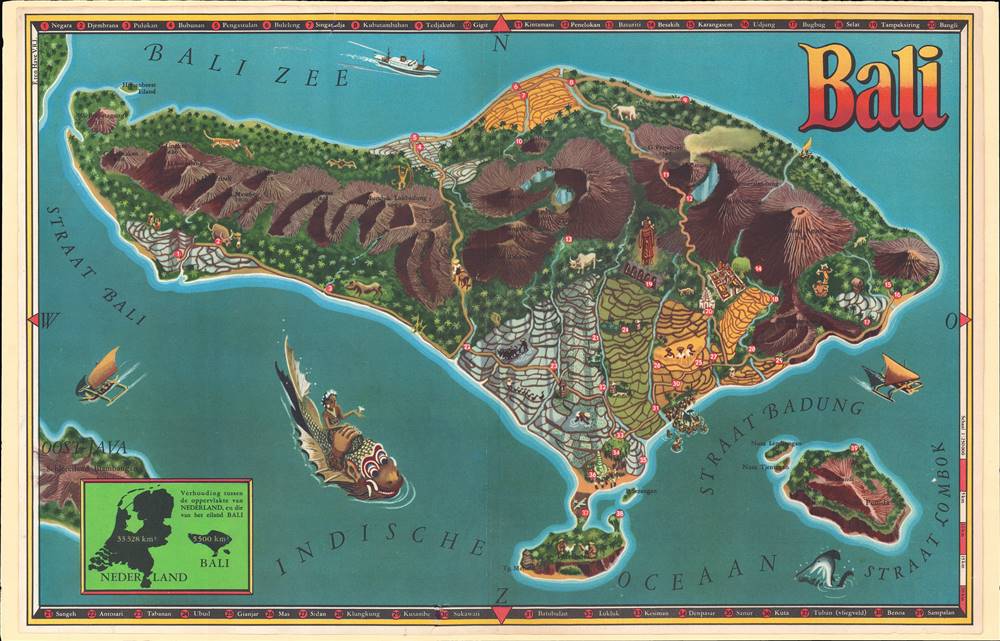1962 François ten Have View of Bali, Indonesia
Bali-tenhave-1962$500.00

Title
Bali.
1962 (undated) 12.5 x 19.5 in (31.75 x 49.53 cm) 1 : 250000
1962 (undated) 12.5 x 19.5 in (31.75 x 49.53 cm) 1 : 250000
Description
This is a rare c. 1962 François ten Have pictorial view of Bali, Indonesia from the book Bali in Kleuren (Bali in Colors). It was produced following the Dutch decolonization at the start of Bali's tourist boom, which has defined the island's economy ever since.
In the years following independence, the island benefitted economically from international tourism, including from the Netherlands and from 'hippies' of many nationalities seeking 'Eastern wisdom.' Tourist hotels opened in succession in the early-mid 1960s and in 1970 the Ngurah Rai International Airport, the site of which is indicated here with number 37 as Tuban airport (vliegveld), was opened, quickly becoming the second busiest airport in Indonesia after Soekarno-Hatta International Airport in Jakarta. This view and the related tourist industry could therefore be seen as an early act of colonial nostalgia by the Dutch public, recreating the benefits of the colonial era (beaches, resorts, friendly natives) while sanitizing its violence and racial inequality.
In recent years, Bali's tourist industry has faced periodic setbacks, such as terrorist bombings in the early 2000s, volcanic eruptions, and the Covid-19 pandemic, as well as environmental degradation caused by mass tourism. Nonetheless, latent demand for tourism, particularly from Australia, China, Japan, and India, seems likely to continue increasing in coming years.
A Closer Look
This view is oriented towards the north, with the island's populous (relative) lowlands in the south at the foreground. Numbers indicate the site of tourist attractions, which are written in the margins around the edge. An inset at bottom-left provides a comparison of the sizes of Bali and the Netherlands. Illustrations depict animals, mythological creatures, Balinese farmers, and fisherfolk riding outrigger canoes. Bali is home to several active volcanos, the highest of which, Mount Agung, at right-center, is considered likely to have a major eruption sometime in the next century (hundreds of minor earthquakes and eruptions took place in 2017 - 2019).Bali and Dutch Colonialism
Cornelis de Houtman, the first Dutch explorer to set foot on Bali, arrived in 1597. Five years later, in 1602, the Dutch East India Company was established. Although a Dutch presence was felt in the region as early as the late 16th century, Bali remained independent of Dutch control until the 1840s and the island would not be fully under Dutch hegemony until the early 20th century.A Tropical Paradise
The mythologizing of Bali as a tranquil paradise had already begun in the 19th century and was spurred on by accounts from Western ethnologists (including Margaret Meade) in the early 20th century. In 1932, a quasi-pornographic ethnographic film entitled Virgins of Bali, ostensibly about Balinese marriage practices, became a popular hit due to its extensive shots of topless Balinese women. Almost overnight the island became a popular tourist destination, presaging the postwar tourist boom that has continued to the present.Decolonization and Independence
As with Indonesia and Southeast Asia as a whole, anti-colonial movements coalesced in the early 20th century, but the death knell for European imperialism came at the hands of the Japanese Empire. Bali was quickly occupied in late February 1942 and an indigenous army composed of anti-Dutch independence fighters and activists was set up. But Japanese rule proved even harsher than Dutch, and resistance increased throughout the war. In the postwar period, decolonization was relatively 'smooth' in Bali, as Republican, anti-colonial sentiment was not as strong there as on Java and Sumatra (Bali is inhabited primarily by Hindus, a minority in mostly-Islamic Indonesia).In the years following independence, the island benefitted economically from international tourism, including from the Netherlands and from 'hippies' of many nationalities seeking 'Eastern wisdom.' Tourist hotels opened in succession in the early-mid 1960s and in 1970 the Ngurah Rai International Airport, the site of which is indicated here with number 37 as Tuban airport (vliegveld), was opened, quickly becoming the second busiest airport in Indonesia after Soekarno-Hatta International Airport in Jakarta. This view and the related tourist industry could therefore be seen as an early act of colonial nostalgia by the Dutch public, recreating the benefits of the colonial era (beaches, resorts, friendly natives) while sanitizing its violence and racial inequality.
In recent years, Bali's tourist industry has faced periodic setbacks, such as terrorist bombings in the early 2000s, volcanic eruptions, and the Covid-19 pandemic, as well as environmental degradation caused by mass tourism. Nonetheless, latent demand for tourism, particularly from Australia, China, Japan, and India, seems likely to continue increasing in coming years.
Publication History and Census
This view is from the book Bali in Kleuren (Bali in Colors, OCLC 64145955), the first edition of which was published in 1951. At least nine editions were published in the following years and this view could be from any of them, but the 9th edition in 1962 is the most widely available and therefore the most likely source.Cartographer
François ten Have (1917 – 2002) was a Dutch water colorist, lithographer, and commercial artist. His art was mostly features in advertisements, but he produced a series of views titled Bali in Kleuren (Bali in Colors) that was popular in the 1950s and 1960s and was printed in at least nine editions. More by this mapmaker...
Condition
Very good. Some wear along edges and in top and bottom margins.

